Mary Anne Yarde's Blog: The Coffee Pot Book Club , page 103
February 18, 2020
#BookReview — Coliseum Arcanist (Frith Chronicles #3) by Shami Stovall #YoungAdult #Fantasy @GameOverStation

Coliseum Arcanist(Frith Chronicles #3)By Shami Stovall
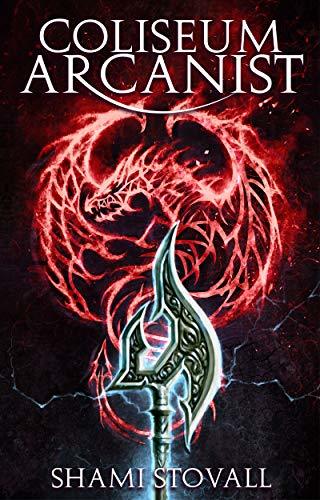
Adventure. Competition. A duel to the death.
While on a journey to the famous city of Thronehold, Volke Savan learns of the Sovereign Dragon Tournament. The massive celebration involves hundreds of arcanists competing for fame and glory, and Volke is determined to win.
Dark forces dwell in the city, however, and rumors of the legendary world serpent spread amongst the shadows. Whoever bonds with a god-like mystical creature will gain magic beyond compare, and the queen’s guards suspect cutthroats will use the chaos of the tournament to hide their plotting.
Unsure of who to trust, Volke investigates the terrible rumors while advancing in the ranks of the tournament. Unfortunately, the true villain may be closer than he realizes…

"Dark times are coming, and we will only survive the changes of our era if we unite our strength against common evils..."
If greatness was forged in the flames of adversity, then the arcanists of The Frith Guild were indeed, great, for their adversities were many, as was, it seemed, their enemies. And now, there was a rumour that a World Serpent, a legendary eldrin, a god-like creature, had spawned, which meant that a fundamental change to magic had transpired. It was feared that the Second Ascension was close at hand.
This was a dangerous time, not only because of the plague that drove both the eldron and their arcanists insane but also because whoever bonded with the World Serpent would have unimaginable power — he would become God-like. It would also signal the end of everything they knew. The Frith Guild had to find the World Serpent before it fell into the wrong hands.
Apprenticed to the infamous Master Zelfree, sixteen-year-old, Volke Savan's life had been dramatically changed when he had bonded with Luthair, a dark and seemingly sinister sentient creature known as a Knightmare. Volke had grown up with stories of the arcanists, and he had dreamt of becoming one. However, he was no longer that naive young man who dealt in dreams. The plague had utterly vanquished Volke's boyhood hero, Gregory Ruma, and Volke had also come face-to-face with his adopted sister's adversary — Dread Pirate Calisto. And now there was this new and terrible threat. If the World Serpent bonded with the wrong person, then this life would be over, forever, for everyone. Volke and his fellow apprentice would travel with The Frith Guild to Thronehold, the capital of the Argo Empire, in search of answers.
But when The Frith Guild finally arrived at Thornehold, they discovered that a new Sovereign Dragon had been born, and the city was preparing for The Sovereign Dragon Tournament. With so many arcanists drawn to the tournament with its promises of prestige and riches, tracking down those who were responsible for the terrible plague and the birth of the World Serpent would be near on impossible. The members of The Frith Guild feared that there would be nothing they could do to stop the Second Ascension.
There is magic. There is adventure. There is romance. Coliseum Arcanist (Frith Chronicles #3) by Shami Stovall is a Young Adult Fantasy triumph in every way. The narrative is mesmerising. The prose is enchanting. Having read the first two books in this series, I was expecting something very magical in this, the third book. Stovall has nailed it. This novel is spellbinding. Once I started, I knew there was no way I was going to put this book down. It is utterly enthralling from start to finish.
As with the other books, this story is told from Volke's perspective. We see everything that he sees. We are privy to his emotions, which gave this book a lovely intimate feel. Volke is a wonderful protagonist who is not only honourable and kind, but he is also very principled. He is not swayed from the path that he has chosen, and nor will his mind be turned against those he admires because of whispered rumours and murmured accusations. Volke is also always willing to give people a chance. His treatment of Fain, a reformed pirate, is a classic example of how he embraces those who others shy away from. Volke doesn't like the idea of someone feeling like they don't belong, and he goes out of his way to help Fain find a place for himself within The Frith Guild. Volke is in all ways, a very admirable, protagonists, and also one that I have thoroughly enjoyed reading about.
The Sovereign Dragon Tournament is a once in a lifetime tournament, and Stovall has given her readers front row seats to this wondrous, violent, magical event. And because of this tournament, Stovall introduces her readers to a vast array of sentient creatures, each one with unique characteristics and abilities. I thought the way Stovall chose to approach how she described all these creatures was incredibly clever. Volke borrows a book from his dear friend, Adelgis', father. This book is an encyclopedia of knowledge in regards to these creatures, and it holds just the right information, to give the reader an idea of the creature that Volke is studying. This approach worked really well, and it certainly made imagining these creatures almost effortless.
I have to mention Adelgis Venrover. Adelgis is a very gentle, very empathetic soul who has spent his life trying to make his father proud. His father is in all ways a narcissist — he is a cold, single-minded academic who will happily experiment on his children. Stovall has introduced her readers to some terrible psychopathic characters in this series, but for me, Theasin Venrover is the one character that I despised the most. The way he treated Adelgis was truly horrendous, and I just wanted to wrap my arms around Adelgish and give him a great big hug, because he is such a deserving character and one so immensely likeable. I was so relieved that he had Volke in his corner because he desperately needed that sort of friend.
Coliseum Arcanist answers so many of the questions that arose in the previous two books, but it also poses a few more, the most pressing one being, what will become of Volke and this wonderfully magical world now that evil has been let loose?
I really hope that Stovall does not stop the adventure with this book because I am not quite ready to walk away from these characters just yet.
I Highly Recommend.
Review by Mary Anne Yarde.The Coffee Pot Book Club.
Pick up your copy ofColiseum Arcanist <!-- /* Font Definitions */ @font-face {font-family:"Cambria Math"; panose-1:2 4 5 3 5 4 6 3 2 4; mso-font-charset:0; mso-generic-font-family:roman; mso-font-pitch:variable; mso-font-signature:-536870145 1107305727 0 0 415 0;} @font-face {font-family:Calibri; panose-1:2 15 5 2 2 2 4 3 2 4; mso-font-charset:0; mso-generic-font-family:swiss; mso-font-pitch:variable; mso-font-signature:-536858881 -1073732485 9 0 511 0;} /* Style Definitions */ p.MsoNormal, li.MsoNormal, div.MsoNormal {mso-style-unhide:no; mso-style-qformat:yes; mso-style-parent:""; margin:0cm; margin-bottom:.0001pt; mso-pagination:widow-orphan; font-size:12.0pt; font-family:"Calibri",sans-serif; mso-ascii-font-family:Calibri; mso-ascii-theme-font:minor-latin; mso-fareast-font-family:Calibri; mso-fareast-theme-font:minor-latin; mso-hansi-font-family:Calibri; mso-hansi-theme-font:minor-latin; mso-bidi-font-family:"Times New Roman"; mso-bidi-theme-font:minor-bidi; mso-fareast-language:EN-US;} a:link, span.MsoHyperlink {mso-style-priority:99; color:#0563C1; mso-themecolor:hyperlink; text-decoration:underline; text-underline:single;} a:visited, span.MsoHyperlinkFollowed {mso-style-noshow:yes; mso-style-priority:99; color:#954F72; mso-themecolor:followedhyperlink; text-decoration:underline; text-underline:single;} .MsoChpDefault {mso-style-type:export-only; mso-default-props:yes; font-family:"Calibri",sans-serif; mso-ascii-font-family:Calibri; mso-ascii-theme-font:minor-latin; mso-fareast-font-family:Calibri; mso-fareast-theme-font:minor-latin; mso-hansi-font-family:Calibri; mso-hansi-theme-font:minor-latin; mso-bidi-font-family:"Times New Roman"; mso-bidi-theme-font:minor-bidi; mso-fareast-language:EN-US;} @page WordSection1 {size:612.0pt 792.0pt; margin:72.0pt 72.0pt 72.0pt 72.0pt; mso-header-margin:36.0pt; mso-footer-margin:36.0pt; mso-paper-source:0;} div.WordSection1 {page:WordSection1;} </style></div><br /><div style="text-align: center;"><span style="color: #666666; font-family: "times" , "times new roman" , serif;"><br /></span></div><span style="font-family: "times" , "times new roman" , serif;"></span><br /><div style="text-align: center;"><span style="font-family: "times" , "times new roman" , serif;"><br /></span></div><span style="font-family: "times" , "times new roman" , serif;"></span><br /><div style="text-align: center;"><span style="font-family: "times" , "times new roman" , serif;"><br /></span></div><span style="font-family: "times" , "times new roman" , serif;"><br /></span><br /><div class="MsoNormal" style="background-color: white; color: #333333; font-size: 14.85px;"><span style="background-attachment: initial; background-clip: initial; background-image: initial; background-origin: initial; background-position: initial; background-repeat: initial; background-size: initial; font-size: 35pt;"><span style="color: #666666;"><span style="font-family: "times" , "times new roman" , serif;">Shami Stovall<o:p></o:p></span></span></span></div><div class="MsoNormal" style="background-color: white; color: #333333; font-size: 14.85px; line-height: 21pt;"><span style="font-family: "times" , "times new roman" , serif;"><br /></span></div><div class="separator" style="background-color: white; clear: both; color: #333333; font-size: 14.85px; text-align: center;"><a href="https://1.bp.blogspot.com/-CTZIZMfLeP..." imageanchor="1" style="clear: left; color: #444444; float: left; margin-bottom: 1em; margin-right: 1em; text-decoration-line: none;"><span style="font-family: "times" , "times new roman" , serif;"><img border="0" data-original-height="243" data-original-width="200" src="https://1.bp.blogspot.com/-CTZIZMfLeP..." style="border: none; position: relative;" /></span></a></div><div class="MsoNormal" style="background-color: white; color: #333333; font-size: 14.85px; line-height: 21pt;"><span style="font-family: "times" , "times new roman" , serif;"><span style="color: #181818; font-size: 16pt;">Shami Stovall relies on her BA in History and Juris Doctorate to make her living as an author and history professor in the central valley of California. She writes in a wide range of fiction, from crime thrills to fantasy to science-fiction. Stovall loves reading, playing video games, entertaining others with stories, and writing about herself in the third person.</span><o:p></o:p></span></div><div class="MsoNormal" style="background-color: white; color: #333333; font-size: 14.85px; line-height: 21pt;"><span style="font-family: "times" , "times new roman" , serif;"><br /></span></div><div class="MsoNormal" style="background-color: white; color: #333333; font-size: 14.85px; line-height: 21pt; text-align: center;"><span style="color: #181818; font-size: 16pt;"><span style="font-family: "times" , "times new roman" , serif;"><br /></span></span></div><div class="MsoNormal" style="background-color: white; color: #333333; font-size: 14.85px; line-height: 21pt;"><div style="text-align: center;"><span style="font-family: "times" , "times new roman" , serif;"><span style="color: #181818; font-size: 16pt;">Connect with Shami: </span><a href="https://sastovallauthor.com/" style="color: #444444; font-size: 16pt; text-decoration-line: none;">Website</a><span style="color: #181818; font-size: 16pt;"> • </span><a href="https://twitter.com/GameOverStation/" style="color: #444444; font-size: 16pt; text-decoration-line: none;">Twitter</a><span style="color: #181818; font-size: 16pt;"> • </span><a href="https://www.facebook.com/SAStovall/" style="color: #444444; font-size: 16pt; text-decoration-line: none;">Facebook</a><span style="color: #181818; font-size: 16pt;"> • </span><a href="https://www.goodreads.com/author/show..." style="color: #444444; font-size: 16pt; text-decoration-line: none;">Goodreads.</a></span></div><span style="font-family: "times" , "times new roman" , serif;"><br /></span></div><div class="MsoNormal" style="background-color: white; color: #333333; font-size: 14.85px; line-height: 21pt;"><span style="font-family: "times" , "times new roman" , serif;"><br /></span></div><div class="MsoNormal" style="background-color: white; color: #333333; font-size: 14.85px; line-height: 21pt;"><span style="font-family: "times" , "times new roman" , serif;"><br /></span></div><div class="MsoNormal" style="background-color: white; color: #333333; font-size: 14.85px; line-height: 21pt;"><span style="font-family: "times" , "times new roman" , serif;"><br /></span></div><div class="MsoNormal" style="background-color: white; color: #333333; font-size: 14.85px; line-height: 21pt;"><span style="font-family: "times" , "times new roman" , serif;"><br /></span></div>
Published on February 18, 2020 21:00
Join Cory B. Scott as he explores the inspiration behind his fabulous book — God's in the Garden #Memoir #amwriting @corybscott1

An Author’s Inspiration
By Cory B. Scott

Imagine what we could change if we changed the way we use our imaginations.

Scientists have discovered that nearly every hemisphere of the brain is engaged when we use our imaginations. This is no little childish mechanism. It is probably the most underrated yet, a dominant part of who we are. It can be used to shape how we see ourselves and how we are seen.

If you don’t believe this, you need to look no further than the woman who writes her name over and over again with the last name of the man she loves to see how imagination can start something. On the other hand, you need to look no further than the example of Ebenezer Scrooge. As the story of the Christmas Carol illustrates, all of his misery and discontent could be traced back to various points in his life where he chose to numb or ignore the positive aspects of this poorly used tool.
Hope and despair start with what you imagine and grow into what you believe. Of all the uncertainty that can be spun from the imagination, it is also the only real source of hope, the only thing that is certain to carry you.
Humans are nervous and unsure creatures. People need firm ground to stand on, a covenant agreement, a lawful decree. Laws that can be tested and weighed against what we can see. Rules and punishments, this is how we get our bearings and what we need to move forward through uncertainty and fear. There are laws of physics, doctrines of the religion, empirical evidence of the senses. Reason, intellect, and law are more comforting and stable to you as an adult and leave little room for imagination.

As a consequence of our desire for certainty as we get older, our imaginations get weaker. We tend to refer to them with condescending statements like “Oh, that was only my imagination,” meaning that because something originated in our minds, it is less real or childish.
I have come to see that this is a colossal mistake and a critical error. It is also a disservice to our abilities, gifts, and our relationships. Our imagination is a gift and a powerful tool we can use to create or destroy. Everything begins and ends in this workspace of the brain. It is also our most powerful mechanism to engage with the unimaginable.
But we find comfort in certainty in knowing what is real, trustworthy, and stable. In a way, it is a form of control for us to know all the inner workings and label them. So when it comes to the unknown, we decide for ourselves if these mysteries should be proclaimed as something to be feared or worshiped.

My imagination brought a lot of negativity and destruction into my life before I learned the power it held. This part of our brain is the most underrated and ignored friend or foe we will ever know. Manipulators and predators used the power of my imagination to trap me into the belief that my fate was connected or dependent on them. I allowed them to capture my imagination with ideas of helping the world or just the department where I worked. I allowed organizations to capture my imagination and lead me to believe I was a part of something big and important, and I gave them so much of myself. This tool, in my mind, my imagination, is where everything begins and ends. It is where seeds are planted that I either water or cast away.
It is the idea that the imagination is just a childish or false part of who we are that can lead to our destruction if we let it. On the other side, what if we acknowledge the power of this force within, and reclaim control over it. Take power back from leaders, organizations, religions, and anyone other than ourselves or that small voice within. It is our tool after all. We can reclaim it and use it for our benefit.
In my book God’s in the Garden I take a journey into the dark uncharted landscape of pain and disappointment in my life. I discovered that I let people, religion, and events control how I felt about myself. I let others control and influence me and they did this by capturing my imagination first. One thing that I learned on this journey is that everything truly does begin and end in our imagination. I realized a lot about the power of imagination and how to take back control of this formidable tool. I determined that I can reclaim this power and use it to bring positivity and hope back into my life.
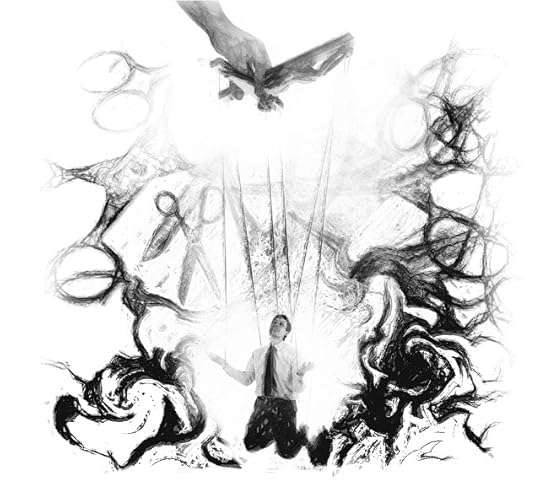
The Book, God’s in the Garden, seizes the essence of a survivor’s journey through abuse, pain, loss, and betrayal, toward enlightenment. This was a long, arduous journey, but it was also an incredibly cathartic adventure. I encourage you to read my memoir God’s in the Garden you will enjoy the experience and the occasional pit stops of poetry, short stories, and original artwork which will capture and captivate your imagination. God’s in the Garden seizes the essence of a survivor’s journey through abuse, pain, loss, and betrayal, toward enlightenment.

It is a unique memoir that not only illustrates the devastation and loss a survivor experienced but also the power of the human spirit and mind. The Power to overcome and heal, and to once again reclaim ourselves, our life, and our imagination. Join me on the adventure; maybe you too will reclaim what has been lost to you in the Garden of your imagination.
God’s in the GardenBy Cory B. Scott

An exhilarating memoir about one man’s journey through physical, emotional, and spiritual abuse to find his inspiring personal awakening.
Shaken by the loss of his mother, drained by his pursuit of a doctoral degree, and conflicted over his experience with illegal and unethical activities in religious organizations, Dr. Scott found himself questioning everything he had been raised to believe. This questioning sends him spiralling down a dark rabbit hole into a new world he never knew existed.
Through original artwork, creative writing, and rigorously honest introspection. Dr. Scott take us all on a journey into the dark places that separate us from unfiltered truth.
Pick up your copy ofGod’s in the GardenAmazon
Cory B. Scott
 Dr. Cory B. Scott has had an adventurous career that has afforded him the honor of such titles as, Doctor, Deputy, Lieutenant, Director, Executive, Reverend, and finally, his true passion, Professor. But those were just titles; He is really just, Daddy, Husband, Brother, Friend, Uncle, Mentor, writer, and finally, in 2019, he was awarded his true love, Grandpa. Cory has survived some devastating and tragic events along his path as well as some personal failures. These experiences have given him deep insight and a desire to help others overcome personal obstacles and transform their tragedies into strength and hope.
Dr. Cory B. Scott has had an adventurous career that has afforded him the honor of such titles as, Doctor, Deputy, Lieutenant, Director, Executive, Reverend, and finally, his true passion, Professor. But those were just titles; He is really just, Daddy, Husband, Brother, Friend, Uncle, Mentor, writer, and finally, in 2019, he was awarded his true love, Grandpa. Cory has survived some devastating and tragic events along his path as well as some personal failures. These experiences have given him deep insight and a desire to help others overcome personal obstacles and transform their tragedies into strength and hope.Cory weaves original artwork, poetry, and stories in an incredible memoir titled, "God's in the Garden." This book captures the essence of a survivor's journey through abuse, pain, loss, betrayal, and enlightenment. Cory is the author of the "Inspiring, Metaphoric, and Psychedelic Stories of Oopy Loopy Provenance." A series of stand-alone stories set in the murky provenances of the heart and the human condition. These adventures explore the depths of our humanity. These crafty works are designed to inspire and help the reader use the power of metaphor to identify and overcome common hang-ups that hold us back from enjoying this life and reaching our full potential.
Connect with Cory: Website • Twitter • Facebook.
Published on February 18, 2020 20:00
February 17, 2020
Join me in Conversation with Historical Fiction author, Richard Foreman #HistoricalFiction #Interview @RForemanAuthor

A Conversation with Historical Fiction author, Richard Foreman
Please give a warm Coffee Pot welcome to Richard Foreman.

MA: Richard, it is lovely that you could join us today. Before we begin, could you please introduce yourself to my lovely readers.
RF: I have worked in publishing, in one form or another, for the past twenty years or so. After working as an events manager for a bookshop I then set-up a publicity and consultancy agency for authors. The era was, in some ways, a golden age for publishing. Life was a series of launch parties and author dinners. Sales were as high as my cholesterol levels. I also had the privilege of working with a number of talented and inspirational writers, including Simon Sebag- Montefiore, Conn Iggulden and Alison Weir. Although their writing and careers differ, most successful authors all share a love of reading and hard work. I then went from publicist to publisher. I enjoy both championing backlist titles from established authors – and also discovering new voices, particularly in historical fiction. Should you read Siege and have written something similar, or wish to do so, I would be happy to hear from you and can be reached via Sharpe Books. No book should be left in the drawer. Being a judge for the HWA Gold Crown and setting up the London History Festival have also been rewarding. Writing my own books was – and is – secondary to my career as a publisher. Originally, I set out to write literally fiction - although A Hero of Our Time and Warsaw are set in WWII and contain thriller-esque elements.

I then decided to write something more commercial. Augustus:Son of Rome was a breakthrough book, both in terms of it being a bestseller and I found a formula and my voice writing within the Roman period. Several Roman books followed – Sword of Rome, Sword of Empire, Spies of Rome – and although I sometimes feel Romed out, so to speak, I’ll always return to the era and genre.

MA: Your career is undoubtedly inspirational. May I ask, what inspired you to write Siege: The First Crusade?
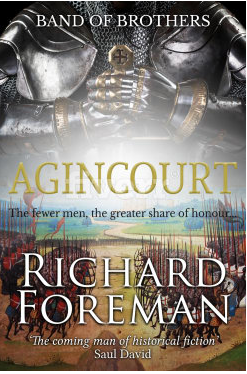 RF: Several years ago, I moved into the medieval period with Band of Brothers, telling the story of Henry V and the Agincourt campaign. The book was a hit and I promised myself – and some fans who contacted me – that I would write another series set in the medieval era. I fell in love with the story of the First Crusade after reading Thomas Asbridge’s book on the subject. I rekindled my interest after reading Steven Runciman. The First Crusade is a story involving conquest, religion, knights, clergymen, triumph and tragedy. It’s relevant – and resonates. The story of the siege of Antioch – and then the Army of God being besieged – interested me on a military and human level. The crusaders were dedicated warriors, as well as being devout Christians. One of the aims of the book, along with other novels I have written, is to pique a reader’s interest enough to go back and read the likes of Asbridge and Runciman. The task of a book is to inspire someone to read another book.
RF: Several years ago, I moved into the medieval period with Band of Brothers, telling the story of Henry V and the Agincourt campaign. The book was a hit and I promised myself – and some fans who contacted me – that I would write another series set in the medieval era. I fell in love with the story of the First Crusade after reading Thomas Asbridge’s book on the subject. I rekindled my interest after reading Steven Runciman. The First Crusade is a story involving conquest, religion, knights, clergymen, triumph and tragedy. It’s relevant – and resonates. The story of the siege of Antioch – and then the Army of God being besieged – interested me on a military and human level. The crusaders were dedicated warriors, as well as being devout Christians. One of the aims of the book, along with other novels I have written, is to pique a reader’s interest enough to go back and read the likes of Asbridge and Runciman. The task of a book is to inspire someone to read another book.MA: The First Crusades is an incredibly interesting time in history. With that in mind, how did you come up with your setting and your characters?
RF: Such is the natural drama and narrative structure of the Siege of Antioch, I was able to remain largely faithful to the real history behind the story. The sacking of Antioch is a fitting climax to the first book in the series, as the sacking of Jerusalem will be a suitable climax to the third and final instalment. As with many of my Roman novels, which revolve around the lives and careers of great figures from history (including Augustus, Julius Caesar, Cicero and Marcus Aurelius), Siege includes portraits of the leading protagonists of the First Crusade. Bishop Adhemar, Bohemond of Taranto and Godfrey of Bouillon feature in the book – and will feature in subsequent titles in the series. Although the First Crusade was predominantly made-up of Normans and Franks, I decided to create two Englishmen to serve as the leading characters in the story. The first is a cynical knight, Edward Kemp. The second is Thomas Devin, an idealistic Christian scribe. The arc of the story involves the former finding some faith during the course of the siege – and the latter losing a part of his devotion and belief. There are plenty of other characters, both fictional and based on real life figures, who populate the story and provide both colour and humour. I’m especially keen to develop the relationship between Edward and Emma. Love as well as war sells.
 Detail of a medieval miniature of the Siege of Antioch from Sébastien Mamerot's Les Passages d'Outremer: Wikipedia.
Detail of a medieval miniature of the Siege of Antioch from Sébastien Mamerot's Les Passages d'Outremer: Wikipedia.MA: Love and war — two sides of the same coin, I believe! There are many books in the medieval/historical genre. Can you tell us three things that set your novel apart?
RF: Although I grew up devouring Bernard Cornwell and George Macdonald Fraser - and have always been conscious of writing within the demands of a genre - authors naturally put their own spin on things. There’s a black and dry sense of humour to Siege that modern-day soldiers will probably appreciate. There is also a slight religious/philosophical element to the story and characters which blends satire with seriousness. But historical fiction should predominantly be entertaining, as opposed to informative. Having written thrillers and crime fiction in the past, Siege has a healthy dose of pace and twists too.
MA: If may ask one more question, can you tell us what you are currently working on?
RF: The day job is currently keeping me busy. Sharpe Books are currently seeking submissions and dealing with the HWA (Historical Writers’ Association) unpublished novel prize. We will also soon publish more collections of short stories by HWA authors. The first book, Rubicon, was a pleasing success. On the writing front however I’ve started to write the sequel to Siege. I still need to finish off the Augustus quartet of books and I am flirting with the idea of writing a series of books set during the Third Crusade. I have recently been approached about staging one of the stories from Raffles: The Complete Innings for a local theatre. The inbox is seldom empty, unfortunately or not.
MA: It certainly looks like you have one very busy and productive future ahead of you, I wish you all the best with it, and I am looking forward to reading the sequel to Siege. Thank you so much for taking time out of your day to chat with us.
If you would like to learn more about Richard’s fabulous book, then you know what to do — Scroll Down!
Siege By Richard Foreman

1098.The crusader army still stands outside Antioch. Starving. Deserting.An enemy force, led by Kerbogha of Mosul, is days away from relieving the walled city.Bohemond of Taranto calls upon the English knight, Edward Kemp, to meet with an agent, who is willing to provide the Norman prince with access to Antioch.But Bohemond is not alone in wishing to capture and lay claim to the prize. Edward must contend with enemies in his own camp.Should the knight's mission fail, then so may the entire campaign.Antioch must fall.Recommended for fans of Bernard Cornwell, Michael Jecks and Conn Iggulden.
'The scenes of battle and clash of cultures are brilliantly depicted.' Jemahl Evans, author of Becket: Warrior
Siege is the first book in a new series, set during the First Crusade, by bestselling historical novelist Richard Foreman.
Pick up your copy ofSiegeAmazon UK • Amazon USRead for FREE with

Richard Foreman
Richard Foreman is a bestselling historical novelist. He is the author of multiple series set in Ancient Rome, including Sword of Rome, Sword of Empire, Spies of Rome and the Augustus saga. He has also written books set in the medieval period, Band of Brothers, and WW2 – Warsaw and A Hero of Our Time. His books have regularly broken through into the top 100 of Amazon and have been widely praised. His new book is Siege, the first in a series of novels set during the First Crusade.
For many years Richard worked as a publicist and literary consultant for numerous bestselling authors, including Simon Sebag-Montefiore, Kate Williams and William Dalrymple. During his time as a publicist Richard founded the London History Festival. He has also served as a judge for the HWA Crowns.
Richard is the CEO of Sharpe Books, one of the leading UK independent publishers. Sharpe Books specialises in publishing crime/thrillers, historical fiction and history books. Authors on their list include Michael Jecks, Sarah Gristwood, Saul David and Peter Tonkin. As well as publishing established writers, Sharpe Books accepts submissions from new authors too. Please see sharpebooks.com should you wish to get in touch and see their submission requirements.
Praise for Richard Foreman's Books
Spies of Rome
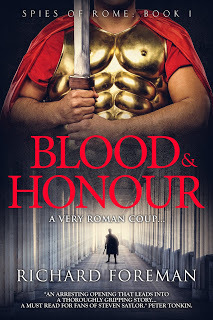 "A masterful and evocative depiction of a fledgling imperial Rome fraught with intrigue and at war with itself. The story and characters are as striking as the graffiti that adorns the violent city’s walls during Augustus' rise."Steven Veerapen, author of The Abbey Close."An arresting opening that leads into a thoroughly gripping story. Impressive research and understanding of the period allows Richard Foreman to move so seamlessly and effectively from historical epic to historical detective thriller. A must read for fans of Steven Saylor." Peter Tonkin, author of The Ides.
"A masterful and evocative depiction of a fledgling imperial Rome fraught with intrigue and at war with itself. The story and characters are as striking as the graffiti that adorns the violent city’s walls during Augustus' rise."Steven Veerapen, author of The Abbey Close."An arresting opening that leads into a thoroughly gripping story. Impressive research and understanding of the period allows Richard Foreman to move so seamlessly and effectively from historical epic to historical detective thriller. A must read for fans of Steven Saylor." Peter Tonkin, author of The Ides.
Amazon
Augustus: Son of Rome
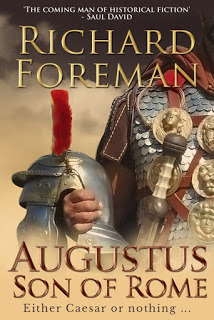
'Augustus: Son of Rome forges action and adventure with politics and philosophy. This superb story is drenched in both blood and wisdom - and puts Foreman on the map as the coming man of historical fiction’.Saul David, Author of the Zulu Hart series.
Amazon
Raffles:
The Complete Innings

‘Classy, humorous and surprisingly touching tales of cricket, friendship and crime.’David Blackburn, The Spectator.
Amazon
Band of Brothers:The Complete Campaigns
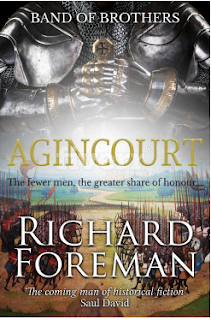 'Escapism at its best... A great read that tells much about the style of war and how the individuals fought.'Michael Jecks.'A rattling good yarn, requiring only the minimum of suspension of belief, and leaves one eagerly anticipating the next instalment of the adventures of the team as they accompany the King to Harfleur.' Major Gordon Corrigan, author of A Great and Glorious Adventure: A Military History of the Hundred Years War.
'Escapism at its best... A great read that tells much about the style of war and how the individuals fought.'Michael Jecks.'A rattling good yarn, requiring only the minimum of suspension of belief, and leaves one eagerly anticipating the next instalment of the adventures of the team as they accompany the King to Harfleur.' Major Gordon Corrigan, author of A Great and Glorious Adventure: A Military History of the Hundred Years War.Amazon
Warsaw

"Warsaw is a work of power. It has the authentic feeling that pulses from an important book. The meticulous research and psychological insights light up one of the most ghastly episodes in the history of man's inhumanity to man."Patrick Bishop, author of Fighter Boys and A Good War.
Amazon
Published on February 17, 2020 21:00
Join #HistoricalFiction author, Jayne Davis, as she takes a look at Prize money and the Army in #Regency times. There is also a chance to check out Jayne's fabulous book @jaynedavis142

Prize money and the ArmyBy Jayne Davis
In Regency times, prize money was paid to both army and navy personnel. The money came from goods captured in action, and was shared out between the men (it wasonly men!) according to their rank. My article in August 2019 (you can read it HERE) explained how prize money was calculated and allocated in the Royal Navy. This article looks at the Army in the Peninsular War.
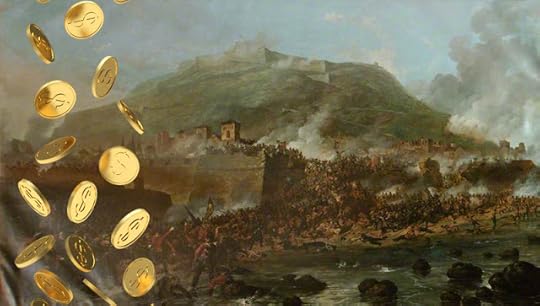 Siege of San Sebastian, Spain, 1813
Siege of San Sebastian, Spain, 1813What was prize money given for?
Royal Navy prize money had a more obvious source than that in the army – captured ships and their cargoes. Army prize money was based on the capture of enemy stores, guns, fortresses, etc. Army money was paid to all soldiers who had taken part in a particular campaign, or their families if they were killed.
Prize money appears to have been paid in 1816 for actions or campaigns between 1809 and 1815. The following 6 payments were announced in the London Gazette:
1 – Ciombria and the Douro2 – The French retreat from Portugal, Fuentes d’Oñoro & Albuera3 – Cuidad Rodrigo and Badajoz4 – The 1812 campaign (Spain)5 – The 1813 campaign (Spain)6 – The 1814 campaign (Southern France).Prize money was also paid after Waterloo.
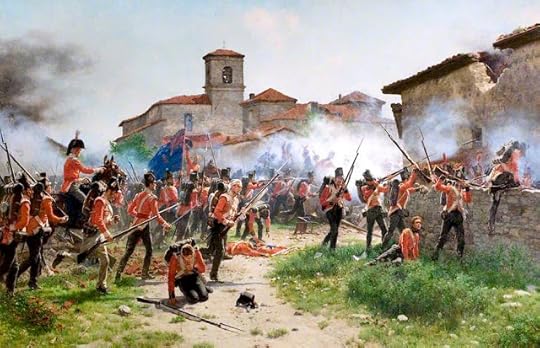 Battle of Vitoria, 1813 – after this battle some British Light Dragoons captured the French Royal Baggage Train belonging to Napoleon’s brother, King Joseph of Spain. Some of the money from this would have gone into the prize ‘pot’, but a great deal was kept by the soldiers, illicitly—including a silver chamber pot which to this day is used for toasts by the King’s Royal Hussars.
Battle of Vitoria, 1813 – after this battle some British Light Dragoons captured the French Royal Baggage Train belonging to Napoleon’s brother, King Joseph of Spain. Some of the money from this would have gone into the prize ‘pot’, but a great deal was kept by the soldiers, illicitly—including a silver chamber pot which to this day is used for toasts by the King’s Royal Hussars.Sharing the money
As in the Royal Navy, prize money was handed out by sharing the amount available between the qualifying men, according to rank. The proportions ranged from 2000 shares for a Field Marshal, 1200 for a General, down to 100 for a Lieutenant Colonel, 80 for a Major, 50 for a Captain and 16 for Ensigns and Cornets (the lowest commissioned ranks). Sergeants got 3 shares, Corporals 1.5 and everyone else just 1.
The amounts actually paid per man not only depended on rank, but on how much money was available and the total number of shares into which it had to be divided. This could vary widely. For example, for the Ciombria and Douro payment, Generals received £106, Captains £11 and Subalterns nearly £5. For the Southern France campaign in 1814, these amounts were £682, £50 and £20, and after the Waterloo campaign (the battle and the subsequent occupation of France) they were £1274, £90 and £34. My source also gives the amount the Commander-in-chief was paid after Waterloo - £61,000!
The average amount received in each campaign by a Colonel and Major was £100 (around three months’ pay for the Colonel, four months’ for the Major), £17 for a Captain, and £7 for a Lieutenant or Ensign. In the last three cases, this was equivalent to one month’s pay. A Private’s share was 1/16 of an Ensign’s share, so they would have received around 8 shillings and 9 pence – equivalent to 8 or 9 days’ pay.
The best way to get rich?
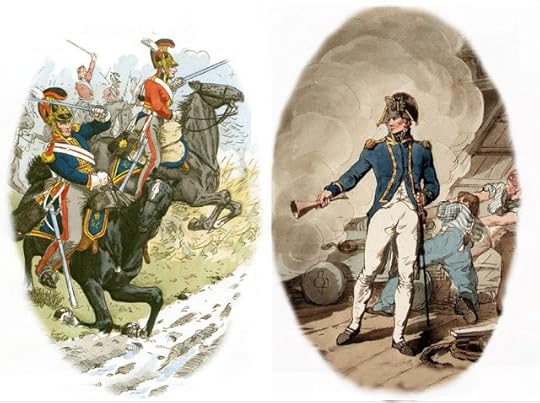
Obviously, the higher your rank the better, but unless you were Wellington with his huge payout after Waterloo, it seems to me that the best way to get rich from prize money was to be the captain of something like a frigate, with an aggressive attitude to the capture of enemy shipping.
The equivalent army rank to a naval Captain is Colonel, and as can be seen above, the average prize money per campaign (and so, roughly, per year) for a Colonel was the equivalent to three months’ pay. A campaign could include several battles or sieges, and a number of skirmishes.
The prize money for a naval Captain could vary much more widely. If his ship took part in many single-ship or small engagements, although the total money to be paid out would be smaller than in a large engagement, the number of people who were entitled to a share of the money was also much lower. A ship could take part in many actions per year, with the potential for prize money for each one, and its captain and crew might get lucky and capture a merchant ship with a valuable cargo.
So, if you wanted to get rich quickly, it would have been the navy for you!
Random aside…
While consulting the treasure trove of facts and figures that I got most of this information from (see reference below), I also came across tables that gave the most common names of officers. Over a quarter of all officers were called either John or William, and other common names were James, Thomas, George and Charles. The Regency was a relatively unimaginative period for given names, but the book also has a small table with some unusual names, including the splendidly named Christmas Knight of the 61stFoot, and Sempronius Stretton of the 40th Foot. I couldn’t resist putting that in!
References: The British Army against Napoleon – Facts, Lists and Trivia, 1805-1815, by Robert Burnham & Ron McGuigan
An Embroidered Spoonby Jayne Davis

The tenuous link between the above article and this book is the hero, who is an ex-soldier, although prize money is not mentioned in the story!
After refusing every offer of marriage that comes her way, Isolde Farrington is packed off to a spinster aunt in Wales until she comes to her senses.
Rhys Williams, there on business, is turning over his uncle’s choice of bride for him, and the last thing he needs is to fall for an impertinent miss like Izzy – who takes Rhys for a yokel.
Izzy’s new surroundings make her look at life, and Rhys, afresh. But when her father, Lord Bedley, discovers that the situation in Wales is not what he thought, and that Rhys is in trade, a gulf opens for a pair who’ve come to love each other.
Will a difference in class keep them apart?
Pick up your copy ofAn Embroidered SpoonAmazonRead for FREE with

Jayne Davis
Jayne Davis writes historical romances set in the late Georgian/Regency era, published as both ebooks and paperbacks.
She was hooked on Jane Austen and Georgette Heyer as a teenager, and longed to write similar novels herself. Real life intervened, and she had several careers, including as a non-fiction author under another name. That wasn't quite the writing career she had in mind...
Finally, she got around to polishing up stories written for her own amusement in long winter evenings, and became the kind of author she’d dreamed of in her teens. She is now working on the first few books in the Marstone Series, set in the late Georgian/early Regency period.
Connect with Jayne: Website • Facebook • Twitter • Pinterest • Goodreads.
Image credits:San Sebastian – Denis Dighton (via Wikimedia Commons, Public Domain)Coins – Deposit PhotosVitoria – James Princep Beadle (via Wikimedia Commons – Public Domain)Cavalry – Richard Knötel (Milgesch) (via Wikimedia Commons – Public Domain)Post Captain – Atkinson, John Augustus (via Wikimedia Commons – Public Domain)
Published on February 17, 2020 20:00
February 16, 2020
Check out Shami Stovall's fabulous #NewRelease — Coliseum Arcanist (Frith Chronicles Book 3) #YoungAdult #Fantasy @GameOverStation
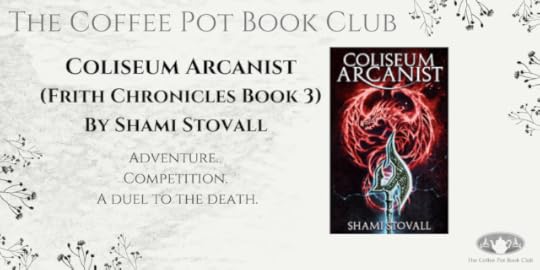
Coliseum Arcanist(Frith Chronicles Book 3)By Shami Stovall
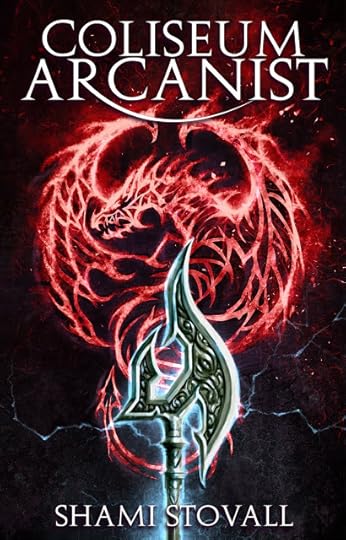
Adventure. Competition. A duel to the death.
While on a journey to the famous city of Thronehold, Volke Savan learns of the Sovereign Dragon Tournament. The massive celebration involves hundreds of arcanists competing for fame and glory, and Volke is determined to win.
Dark forces dwell in the city, however, and rumors of the legendary world serpent spread amongst the shadows. Whoever bonds with a god-like mystical creature will gain magic beyond compare, and the queen’s guards suspect cutthroats will use the chaos of the tournament to hide their plotting.
Unsure of who to trust, Volke investigates the terrible rumors while advancing in the ranks of the tournament. Unfortunately, the true villain may be closer than he realizes…
Excerpt
The moment day broke and light poured onto Ellios, the white marble shone as though the whole city had been carved from a full moon. Even the walls, which stood fifteen feet high, were ivory beyond compare. I stared with wide eyes the entire walk up to the city gates, enamored by the pristine beauty.
We were ushered through without hassle and then greeted by a city with grid-like streets and organized buildings. The stones of the sidewalks had been arranged in squares—large stones around the outside, smaller stones on the inside—all with precision, as though thought had gone into the placement of even the smallest pebble.
Growing on the mountainsides in both directions were massive forests of evergrow trees. Their canopies laced together to create a thick roof of green leaves, and it was almost difficult to see their twisted trunks. Once I did, however, I understood why they were so valuable.
Each tree appeared to have been cut down several times. Remnants of the old trunk created the foundation for the new tree—it grew in all directions from the stump of the previous tree that had been cut. As long as the roots stayed intact, it seemed as though the tree would grow forever, hence its name.
A river ran at the far end of town, and I could already tell by the industrial smoke that was where they kept their furnaces.
While the caravan stopped at the largest inn in the city, Zaxis, Hexa, Adelgis, and I waited on the street corner, observing the sights. Although Fain had asked to accompany me, I hadn’t seen him since last night. He would work on his own time, I supposed.
“Minerva owls dwell in the forest,” Adelgis said, pointing to the sides of the mountain. “My father helps with the bonding ceremonies every five years when the owlets are ready to leave the nest.”
“So they’re owl mystical creatures?” Hexa asked.
“That’s right. They’re quite intelligent. Their trial of worth involves puzzles. My father once helped with crafting them. Now my mother helps.”
“Oh, you have a mother?”
Adelgis faced Hexa, his brow furrowed. “Of course. What kind of question is that?”
She snickered, amused by her own sarcastic joke. It took Adelgis several painful seconds before he put it all together.
“Ha ha. Very funny.”
Zelfree emerged from the posh inn, his dark outfit a harsh contrast to the white and bright green of the city. He flipped up the collar of his coat, like the radiance of our surroundings was one of his hidden weaknesses. Traces sat perched on his shoulder, her long cat tail swishing back and forth as Zelfree hurried across the street and headed straight for us.
“We aren’t staying here long,” he said as he stepped up onto the sidewalk. “Adelgis, you’re coming with me. We’re going to visit your father.”
“Right now?” Adelgis fidgeted with the edges of his sleeves. “He’ll be busy.”
“I don’t care.”
“He’s never in a good mood when people interrupt him, though. Maybe we should visit him on the way back. With plenty of warning ahead of time.”
The desperation in Adelgis’s voice worried me. Zaxis and Hexa even exchanged questioning glances, like they had heard it, too.
“I need to speak with him,” Zelfree said. “And this is important. Whatever he’s doing can wait.”
“Can Volke come?”
The question surprised me, but I had to admit, I wanted to go. Adelgis spoke of his father nonstop, and it made me curious.
Zelfree shrugged. “Sure. He can come.”
“And Zaxis?” Adelgis added.
That addition shocked me. Zaxis perked up and jumped at the opportunity to include himself. We were the only two other apprentices who knew Adelgis’s secret, so it made sense, but the hurt look on Hexa’s face made me feel guilty.
“Fine,” Zelfree stated. “We just need to settle this quickly.”
Traces pointed with the tip of her tail. “That way, my arcanist. I can already sense those weird creatures he likes to collect.”
Pick up your copy ofColiseum ArcanistAmazon UK • Amazon US • Amazon CA
Shami Stovall
 Shami Stovall is a multi-award-winning author of fantasy and science fiction, with several best-selling novels under her belt. Before that, she taught history and criminal law at the college level, and loved every second. When she’s not reading fascinating articles and books about ancient China or the Byzantine Empire, Stovall can be found playing way too many video games, especially RPGs and tactics simulators.
Shami Stovall is a multi-award-winning author of fantasy and science fiction, with several best-selling novels under her belt. Before that, she taught history and criminal law at the college level, and loved every second. When she’s not reading fascinating articles and books about ancient China or the Byzantine Empire, Stovall can be found playing way too many video games, especially RPGs and tactics simulators. If you want to contact Shami, you can do so at the following locations: Website • Twitter • Facebook.
Published on February 16, 2020 21:00
Join Historical Fiction author, Brook Allen, as she takes a look at Lupercalia: Ancient Rome’s Fertility Festival #History #AncientRome @1BrookAllen
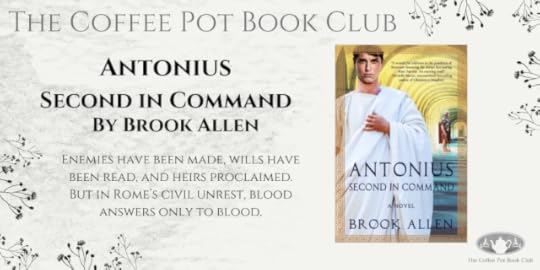
Lupercalia Ancient Rome’s Fertility FestivalBy Brook Allen
Inside a cavern-like grotto overlooking the Circus Maximus, Marcus knelt on the stone floor with the handful of other naked men chosen to run for Lupercalia. Legend held this to be the very cave where a she-wolf suckled Romulus and Remus.
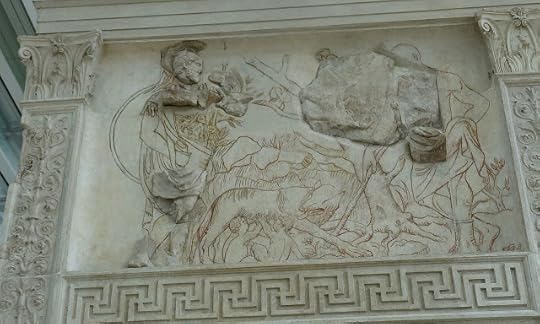
Indeed, the Roman festival of Lupercalia was grounded in the legend of Romulus and Remus—the twin brothers who were destined to become synonymous with the founding of Rome. And most of Rome’s attested history from the 7th and 8thcenturies BC does point to the Palatine Hill as being the original “acropolis” of the city. Whether Romulus and Remus actually lived there—who knows? Back in 2007, an archaeological dig, beneath the Houses of Livia and Augustus, revealed a grotto that some historians argue is the original Lupercal cave. However, recent studies suggest it’s simply a nymphaeum.Wherever the location of the Lupercal cave was, each February 15th, young noblemen between the ages of 20-40 were selected as “luperci” who would participate in purifying and fertility-bestowing rites as they “ran the Lupercal”. Truly, the very name of the month “February” is derived from two terms associated with Lupercalia. First, there was a minor deity based on a god from Etruscan times, named Februus. He was often likened to mythological fauns and since they had a tendency for being randy, the Romans probably selected him to be honored in this festival. Secondly, the strips of bloody skin from the sacrifices, used to smack women in the hopes that they’d conceive, were known as “februa”. One priest handed him a narrow slice of goatskin to cover his loins. Marcus tied it about his waist and between his legs. Bowing his head obediently, he opened his hands. Within moments, slick warm strips of newly shredded dog and goat hide februa were placed atop his palms. Clumsily, he braided them into a whip to be used on women passing his way. Another priest offered him another silver basin of blood, and he dunked the braided februa into it, letting it soak. After removing it, his hands were red and dripping, as was the februa.Typically, goat and dog sacrifices were made as expiations against evil. They were then skinned and used like whips to hit women who were hopeful of having children within the year. To us, it sounds positively barbaric to have killed innocent animals (especially dogs!) in this fashion and for this bizarre purpose. However, this was a pre-Christian era rite and in Roman society at the time, animal sacrifice of all sorts was a daily routine in temples throughout the city.First out of the cave, Marcus bolted down the narrow path where girls were already waiting, hitching up tunics and exposing bare legs, thighs, and buttocks. Warmth pulsed through his veins despite the chill air, warming him. The sight of comely women baring extremities charged his blood.The Lupercalia must have been a rowdy festival, and also proves how superstitious the Romans were, as even high-born women were happy to participate if being swatted by a februa meant getting pregnant. And that brings me to my favorite Lupercalia story! Marc Antony, my main character in the Antonius Trilogy, was selected as one of the Luperci—the men who ran the course of the Lupercal. His participation was not approved of by everyone. Cicero in particular balked at the thought of a serving consul running through the streets half naked. But Antony being Antony probably LOVED every minute of it! However, the mention of his current office enables us to date this Lupercal event to 44 BC. This was but a month away from Caesar’s demise on the Ides of March. Militarily trained, he ran well ahead of the others. Women and men pressed close about him, screaming. Now at the foot of the Palatine, he entered the Forum. The Lupercal route through Rome would end at the Rostra, where Caesar waited, sitting on a recently bestowed golden throne.Most people probably recall this story from Shakespeare’s Julius Caesar; Antony offering Caesar a crown repeatedly, and Caesar turning it down… Well, far from being legend, this incident probably really happened.
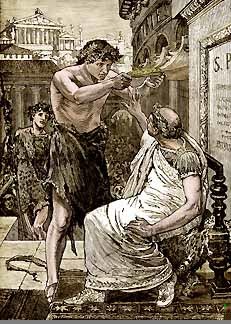
Plutarch, a biographer living at the end of the 1st century AD tells about it in detail in his Life of Antony. Nobody knows for sure, but it’s likely that Caesar put his fellow consul up to the task, curious as to the opinion of the people regarding a possible kingship.So is there any relation between Lupercalia and Valentine’s Day? Well, there was a beloved Christian back in the 3rd century AD known as Valentine. He was martyred on February 14th—the day before Lupercalia. Known for assisting captured Christians and helping young couples who were Christians to safety during one of the later persecution periods, he was a beloved figure. After Lupercalia was banned and Christianity legalized, Valentine was canonized and honored on the supposed date of his martyrdom—February 14th. Thus began the yearly celebration, known as St. Valentine’s Day.
 Saint Valentine.
Saint Valentine.In researching the ties between the ancient rites of Lupercalia and how they might have “morphed” into Valentine’s Day, I’m skeptical that that was the case here. There may have been some symbolism, such as the color red—originally the color of a bloody februa, used in the fertility rite. But even that seems to be a stretch. There just isn’t much hard evidence that the Lupercalia “became” Valentine’s Day. Roman history lover that I am, I’ll keep them separate. I’ll accept my roses from my husband with a broad smile and a kiss and leave the running of the Lupercal to my main man, Marcus!Bare feet hammering the pavement, sweat beaded Marcus’s forehead, spiting the cold. Every single exhale turned to mist in the clear morning air. Prostitutes at a food stall whistled and called as he passed, admiring his lean, powerful body. His muscles were rigid whenever he stopped suddenly or whirled about, lashing out with his februa to switch a hopeful female. Part of the crowd started shouting his name in rhythm, so he lifted his februa, grinning and waving at them in response.(Italicized portions are from Brook Allen’s Antonius: Second in Command)
Antonius: Son of Rome
By Brook Allen

For over two-thousand years, Marcus Antonius—Marc Antony—has been one of history’s most controversial men. His story was buried with him and written by his enemies. Now his entire saga is revealed in a compelling trilogy by Brook Allen.
After young Marcus Antonius’s father dies in disgrace, he yearns to restore his family’s honor during the final days of Rome’s dying Republic. Marcus is rugged, handsome, and owns abundant military talent, but upon entering manhood, he falls prey to the excesses of a violent society. His whoring, gambling, and drinking eventually reap dire consequences. Through a series of personal tragedies, Marcus must come into his own through blood, blades, and death. Once he finally earns a military commission, he faces an uphill battle to earn the respect and admiration of soldiers, proconsuls, and kings. Desperate to redeem his name and carve a legacy for himself, he refuses to let warring rebels, scheming politicians, or even an alluring young Egyptian princess.
The Coffee Pot Book Club
Book of the Year Award Winner
2019

Amazon
Antonius: Second in CommandBy Brook Allen
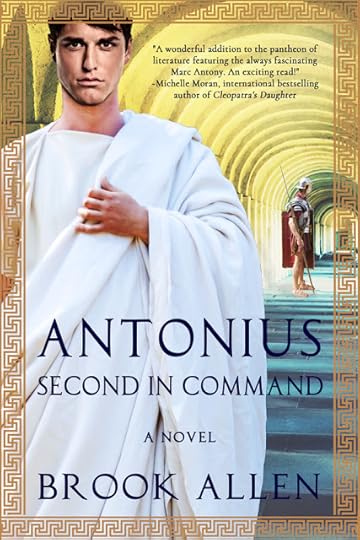
The Antonius saga continues…
Having proven himself as a formidable cavalry commander, Marcus Antonius finally earns a position at his kinsman Julius Caesar’s side. However, Caesar is an exacting general, demanding complete allegiance from his staff, even when his decisions put him at odds with the Senate. Marcus’s loyalty to Caesar comes at a cost, and he soon finds himself embroiled in mob violence and military mutinies. As civil war brings Rome’s Republic crashing down, many a relationship is torn asunder, including Marcus’s marriage. Determined to rise triumphant in Rome’s new era, Marcus faces his fears, his failures, and his enemies—not the least of whom is himself.
Amid the crisis of the Ides of March, Marcus must don the mantle of ruthlessness to carve his own legacy in Rome’s history. Enemies have been made, wills have been read, and heirs proclaimed.
But in Rome’s civil unrest, blood answers only to blood.

Amazon
Brook Allen
 Brook Allen is a Music Educator in a rural community near Roanoke, VA. Aside from her regular classes, she teaches two ensembles, a Chorus and Recorder Consort. Born in Salt Lake City, UT, Brook was raised in Omaha, Nebraska and has lived all over the U.S., from the Pacific Northwest, all the way down to Florida. She graduated with a B.A. in Music Education and has a M. A. in Liberal Studies, with an emphasis on Roman History. Brook is happily married and has two energetic Labrador Retrievers. Voraciously active, she cycles, hikes, and loves to travel.
Brook Allen is a Music Educator in a rural community near Roanoke, VA. Aside from her regular classes, she teaches two ensembles, a Chorus and Recorder Consort. Born in Salt Lake City, UT, Brook was raised in Omaha, Nebraska and has lived all over the U.S., from the Pacific Northwest, all the way down to Florida. She graduated with a B.A. in Music Education and has a M. A. in Liberal Studies, with an emphasis on Roman History. Brook is happily married and has two energetic Labrador Retrievers. Voraciously active, she cycles, hikes, and loves to travel.Connect with Brook: Website • Twitter • Facebook.
Published on February 16, 2020 20:00
February 13, 2020
#BooReview — The Occupation by Deborah Swift #HistoricalFiction #WW2 @swiftstory
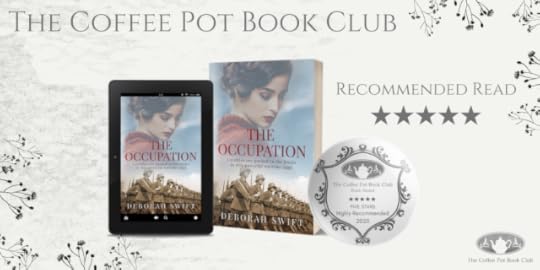
The OccupationBy Deborah Swift
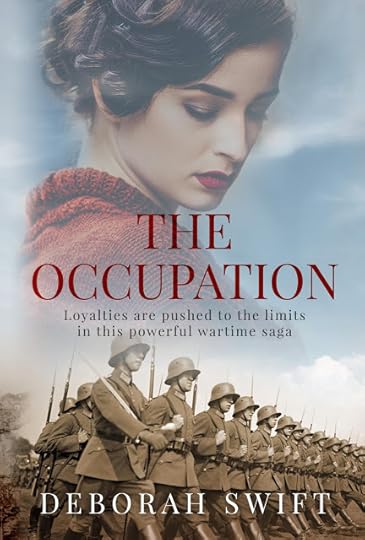
One woman’s secret war against the Nazis. One man’s war against himself…
1940, Jersey
When Nazi forces occupy Jersey in the English Channel Islands, Céline Huber, who is married to a German, must decide where her loyalty lies.
Love for her island, and fear for her Jewish friend Rachel, soon propel her into a dangerous double life.
Meanwhile, Céline’s husband Fred is conscripted into the Wehrmacht in occupied France.
Horrified by Nazi acts of atrocity and torture, he soon becomes a double agent for the French Resistance.
But when things go wrong, and his Nazi masters discover his true allegiance, he finds he has the whole of the German Army on his tail.
How far will Céline go for her best friend? Will Fred make his way home to her?
Or will their lives be changed forever by the brutality of war?

"They won't come here. The Jersey Evening Pos t says these islands are not worth conquering. At least, not unless Hitler wants an ice-cream and a ride on a donkey."
But come they did, and they occupied the Channel Islands in far greater numbers than the tourists ever had. The British had tried to evacuate the islands, of course, before Churchill demilitarised it, but there were not enough boats for everyone. For Céline Huber, there was nothing to be done other than endure the occupation. As for Céline's best friend, Rachel Cohen would spend the next five years in hiding, for Rachel was a Jew, and everyone had heard the rumours about the camps the Jews were sent to.
Céline's husband, Siegfried "Fred" Huber's war was very different from that of his wife's. For Fred was German, and he had been conscripted into the German Army. Fred knew nothing about war. He was a pâtissier, a baker. He feared he would never survive the front, and he would never see his beloved Céline again. However, Fred's war would not be fought at the front, and surprisingly, nor would it be fought for Germany.
From a beautiful summer’s day spent on one of Jersey's sandcastle-perfect beaches to the day Céline learns the truth about her husband's war, The Occupation by Deborah Swift is the heartbreakingly poignant story of one young couple whose lives are irrevocably changed forever by the outbreak of World War 2.
Initially, The Occupation by Debora Swift was published as a short -story in The Darkest Hour: WWII Tales of Resistance, which was in aid of the United States Holocaust Memorial Museum in Washington DC in 2019, and it was in that anthology that I first read it. Swift decided to republish this book as a full-length novel, and I have been on tenterhooks waiting to read it.
The Occupation is a tender exploration of what life was like for the islanders as they suffered five very long years under German military occupation during World War 2. With an impressively sweeping narrative and beautifully presented prose, Swift has bestowed upon her readers a book that is as majestic as it is brilliant. I am so glad Swift decided to relaunch this novel because it is an utterly enchanting, heart-rending tale, of war, occupation, friendship, and love.
The Occupation isn't a story of good verse evil — although there is plenty of evil to go around — it is instead an exploration of the human soul. How often can you look away from unimaginable suffering? What would you risk to save someone you cared about? How quick are you to judge your neighbour? And are you really a traitor if you dare to stand up and fight for the persecuted? All of these questions, Swift asks her readers through the actions of her protagonists.
The Channel Islands have always held a special place in my heart, and even today the fortifications can still be found on the islands — a sinister reminder of The Atlantic Wall. The story about the war from the islanders’ perspective is not unique, but it is indeed rare, and to find a story that has captured the very essences of the community during this era is a real treat. I felt like I was back on Jersey, only many years before my time!
Céline Huber is a wonderful heroine. Her story is one of hardship, suffering, heartache, and abuse. However, Céline endured everything that befalls her with grace and a tenacious belief that no matter how hard it gets, no matter how awful her life is, one day the mines will be cleared from the beaches and will be replaced by sandcastles. Her loyalty to her friend, Rachel, is absolute. She will do anything. She will bear everything if it keeps Rachel from falling into enemy hands. I thought Swift really surpassed herself with Céline's depiction. Her character is so very vivid in the telling and so very brave. This is a protagonist that a reader can really get behind.
What was there not to love about Fred Huber? Fred didn't want to go to war. He loves his wife to distraction, and he just wants to be back in Jersey, with Céline safely held in his arms. But as much as he longs for an end of a war, for a return of normality, the first thing he has to do is survive. But unlike the majority of men who felt they had no choice but to obey orders, Fred dares to think for himself. Placed as a spy in war-torn Paris to root out the leaders of La Résistance, Fred faces some tough decisions — does he stay faithful to the Fatherland, or not? As well as a spy, Fred is a translator and some of the things he is asked to translate freezes his heart and makes it easier to come to a decision. He thought he was a patriot, but Germany, under the Nazi regime, is going down a road Fred cannot follow. And hence the baker, the pâtissier, feels he has no other option than to fight for La Résistance. Fred's journey is a humbling story of the difference one man can make when you stand up to unimaginable evil. His conscience will not be silenced. He has to help La Résistance — he does not see any other choice. I adored everything about Fred. He is this lovely gentleman who would rather die than see his friends suffer at the hands of the SS. Fred's story left me in tears on more than one occasion, it is utterly harrowing and reminded me greatly of the late 1980's television show Wish Me Luck by Lavinia Warner and Jill Hyem. It has the same desperate feel.
There are several antagonists in this book — from neighbours who are more than happy to point fingers and shout accusations, to Fred's own brother. War does strange things to people, it is said, and Swift has certainly captured every conceivable emotion. At times the things the antagonists do, make for some challenging reading, but war is brutal, and Swift hasn't shied away from that fact.
The attention to the historical detail has to be commended. Swift has obviously spent many long hours researching what it was like in Jersey during the occupation, as well as what it was like in France. This novel has a large canvas, and the events that Swift depicts are as accurate as she could possibly make them, but then by adding in the human fragility and the suffering that this atrocious war caused, makes this book terribly difficult to put down.
The Occupation by Deborah Swift is a work of incredible scholarship, and it is in all ways a Historical Fiction success. This is a book that deserves to be read again and again.
I Highly Recommend.
Review by Mary Anne Yarde.The Coffee Pot Book Club.
Pick up your copy ofThe OccupationAmazon UK • Amazon US
Deborah Swift
 Deborah Swift is the author of three previous historical novels for adults, The Lady’s Slipper, The Gilded Lily, and A Divided Inheritance, all published by Macmillan/St Martin’s Press, as well as the Highway Trilogy for teens (and anyone young at heart!). Her first novel was shortlisted for the Impress prize for new novelists.
Deborah Swift is the author of three previous historical novels for adults, The Lady’s Slipper, The Gilded Lily, and A Divided Inheritance, all published by Macmillan/St Martin’s Press, as well as the Highway Trilogy for teens (and anyone young at heart!). Her first novel was shortlisted for the Impress prize for new novelists.She lives on the edge of the beautiful and literary English Lake District – a place made famous by the poets Wordsworth and Coleridge.
Connect with Deborah: Website • Facebook • Twitter • Goodreads.
Published on February 13, 2020 20:00
February 12, 2020
#HistoricalFiction author, Douglas A. Burton, is sharing the inspiration behind his fabulous book — Far Away Bird @douglasaburton

Author Inspiration: The ByzantinesBy Douglas A. Burton
For 25 years, I’ve read about the Byzantine Empire. Now that I’m writing this blog, I realize that very few people have ever asked me why, and how I became so passionately intrigued by the Byzantines. Only a few of my closest friends and family members know about my unusual side passion. Even they don’t ask “why” anymore. Reading about Byzantium was just something I did on my own, in private, while leaving little trace evidence in my regular life. It’s a niche fascination that rarely found its way into regular conversations. Whenever I do end up mentioning something about the Byzantine Empire, or that the capital was Constantinople, the most common response I get (and I’m not kidding) is a pause and then a cheery rendition of Istanbul Not Constantinople. So now it’s Istanbul, not Constantinople, and we all get that.But how did this particular time and place in the world come to capture my imagination so entirely? Like many things for me, the culprit was a book.I can actually tell you the exact day my fascination with the Byzantine Empire began. It was on March 10th, 1993. I know this because the library card is still inside the book cover to this day. The book was a non-fiction work called Constantinople: Birth of an Empire by Harold Lamb, and it was published way back in 1957. During my 1993 study hall, though, I just needed a book to pass the time because I surely wasn’t going to do my Algebra homework. So, I flipped through the pages, and the musty scent of old paper really set the tone. There were some black & white pictures on a few pages depicting a mosque-like building of some kind, various mosaics, and stone reliefs. I turned back to the first page and started reading:

The author opens with: This is the story of a city built by survivors. As often happens in a great disaster, these survivors were not one people ethnically, but a fusion of many peoples. They gathered together to defend not so much their lives and property as their way of life. In so doing, they displayed a certain perversity; they refused to surrender their city. They kept on refusing for nearly a thousand years. History has named them the Byzantines…So, wait a minute, I thought. This sounds nothing like the Roman Empire I learned about in any schoolroom. The Romans were of one people ethnically, you know…the Romans? So, this account baffled me. The Roman Empire was a civilization built by brute conquerors, not desperate survivors. The author goes on:They were alone in their survival. In the West, a long twilight fell on the Roman Empire during the centuries between A.D. 200 and 450. It ended in the darkness of the first Middle Age. In the East, however, the inhabitants of this city learned the hard lessons of disaster, and they managed to hold back the night.Images of invincible Roman legionnaires, of architectural splendor, and ancient decadence all seemed at odds with the rather morbid tone the book struck. What the hell was this guy talking about? I flipped to a map in the index and got a better idea. The Roman Empire had been split in two at some point, a west and an east empire. I remembered hearing something about the split but then also realized that I never heard about what happened to that eastern portion of the empire. It was like the weird old uncle you meet at a family reunion and never hear from again.
Here’s what I’m talking about:
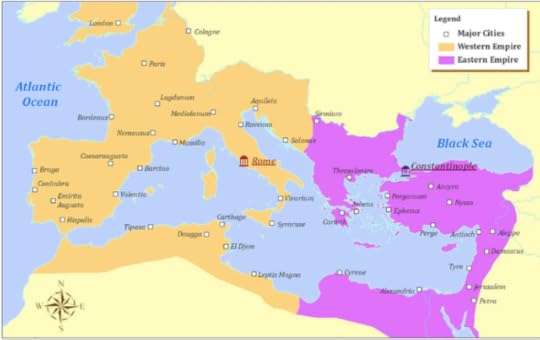
So, apparently, the Roman Empire we all study in school is the green part, the western part, the European part with its iconic boot of Italy kicking Sicily, and with the familiar shapes of France, Spain, and England facing the Atlantic Ocean. But there’s that whole red side, the less European side, the more Middle-Eastern side, which clearly includes Greece, the Balkans, Turkey, Lebanon, Syria, Jordan, Israel, Egypt, and some of Libya. Even today, that red side includes a rare fusion of diverse cultures that actually encompasses three continents—Europe, Asia, and Africa.The author then launches into a spellbinding account of the late Roman Empire—not in its glory—but in the spasms of a violent death throe. He painted a picture of an absolute catastrophe. I still get goosebumps remembering the tale. Civilization had failed in totality.Rome was sacked. Pillaging went on uncontested and tiny villages were left to fend for themselves. Barbarians migrated freely through the once secure interior of the empire. Imperial highways fell into disrepair. Stray cows milled about in the ruins of monuments, where nature crept back to reclaim the space. Roman soldiers deserted and joined the enemy. Noble families sailed out to escape their doom, only to be captured and sold into slavery. My seventeen-year-old self beheld a disaster on a scale so great that my imagination filled with epic oil painting-like scenes. And the story kept getting worse.
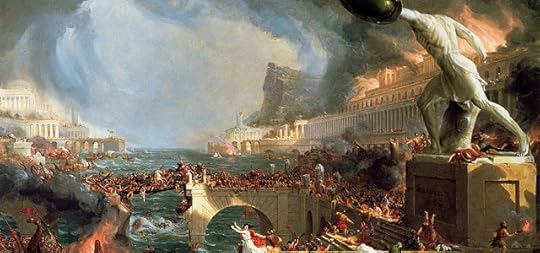 Thomas Cole’s ‘The Course of Empire’ series: Wikipedia
Thomas Cole’s ‘The Course of Empire’ series: WikipediaVarious people made radical attempts at survival in remote pockets…and failed. Desperate Roman emperors passed equally desperate policies in hopes of staving off the ruin of the empire…and failed. Finally, the black shadow of the Dark Ages truly descended upon a world that had actually lost the ability to function or even exist. I was amazed at such a thorough regression of a flagship human civilization. But in the East, on the side of the world we rarely talked about in class, I suddenly discovered that half of the Roman Empire survived. That “red section” had a history of its own, and it deviated quite a bit from the Roman Empire I understood.
The eastern empire was a second, bizarre Roman Empire, divorcedfrom Europe, which didn’t even include the ancestral capital of Rome. The citizens spoke mostly Greek, not Latin. They were Christian, not pagan. They were the former conquered provinces, not the founding homeland. And from the ashes of the fallen western empire, I discovered that this eastern Frankenstein remnant of the Roman Empire would come to be known as the Byzantine Empire. These people and their empire would come to dominate the Medieval Era as the superpower of the world, exploding in culture, influence, and art.They had little in common with the Dark Age and barbarism occurring in Europe. Moreover, the Byzantine Empire would go on ‘surviving’ for over a thousand years, making it one of the longest-lived civilizations ever.In one quick stroke, my study hall that day shattered everything I thought I knew about the Roman Empire, of Western civilization. My belief that history represented steady upward progress fell short. I never considered that we could regress to decisively.I was so enchanted by the world I found in those ages that I pretended to lose the library book rather than return it. I paid the $18 lost fee and proceeded to horde this book my whole life.In these pages, I met a beautiful cast of historical figures I’d otherwise never heard of, heroes and heroines who called themselves Roman but wore Asian or Russian-looking gowns and gaudy bejeweled crowns. I discovered a Byzantine general, named Belisarius. He was Justinian’s prime general and is considered a military genius. He’s considered one of the top military minds in all human history. See for yourself. Google ‘top 100 generals of all time. Or, click HERE!Again, to my shock, I learned something that I neverheard about in school. Remember that colorful map above, half-green and half-red? Well, Belisarius manages to reconquerthe entire green section, single-handedly reuniting the Roman Empire for a generation. Impossible to believe! The civilized world fought back against the barbaric dark age. I also read about a peasant named Petrus, who left his pig-farming village in modern Macedonia to go on to become arguably the greatest Byzantine Emperor in history. He takes on the name of his adopted father and becomes Justinian.And then there’s his wife, Empress Theodora, whom history has never been more uncomfortable acknowledging. She had been a lowly prostitute, well known for her infamy in the seedy entertainment districts of Constantinople. She was essentially a medieval stripper and sex performer, who goes on to become a powerful intellectual contributor to Byzantine law and culture. Theodora’s undeniable influence on a sweeping legal overhaul may indeed represent the first official laws designed specifically for the betterment of women, and directed by a woman.
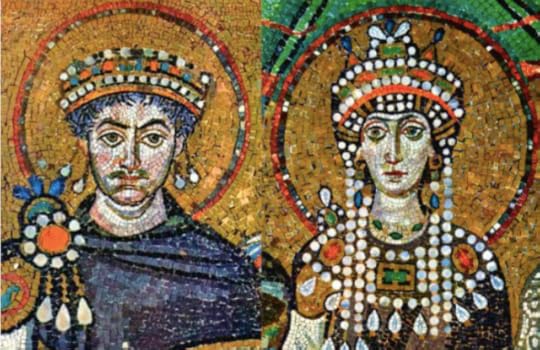 Mosaics of Justinian and Theodora in St. Vitale in Ravenna, Italy.
Mosaics of Justinian and Theodora in St. Vitale in Ravenna, Italy.So, that one book opened me up to all of these aspects. Thiswasn’t the Dark Ages of Europe. This was a golden age of Byzantium. Sometimes, learning about Byzantine history feels like I’m unearthing a deep historical secret ala The Da Vinci Code or the lost city of Atlantis. And this is made all the more maddening that nearly no one knows much about it. Here’s a fun little test. Name a major movie, television show, or novel that has the Byzantine Empire as a setting. No, really, name one.I mean, we have movies set in ancient Greece, Ancient Egypt, Rome, Medieval Japan, Medieval China, South America, the Mayan Empire, Antarctica, Middle-Earth, Mars, and Tatooine. And yet, I bet you cannot come up with a single relevant story set in the Byzantine Empire. Seriously. Why?Most of our perception of the Byzantines is found indirectly with our fascination with the eastern European mystique. We see it in stories like Bram Stoker’s Dracula, which takes place in Romanian Transylvania and has an occultic Byzantine feel, or Agatha Christie’s Murder on the Orient Express. We see the Hagia Sophia in movies like From Russia with Love, The International¸ or Tom Hank’s Inferno. And most recently, Millennials walked on the streets of 16th Century Constantinople in the critically acclaimed video game, Assassin’s Creed: Revelations. But these are just scant traces of Byzantium in our culture.
 Bram Stoker's Dracula (1992 film): Wikipedia.
Bram Stoker's Dracula (1992 film): Wikipedia. 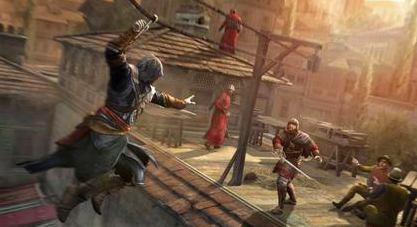 Assassin’s Creed: Revelations: Wikipedia.
Assassin’s Creed: Revelations: Wikipedia.And yet history is incomplete without the Byzantines. For example, I was always told that Western Europe just kind of ‘woke up’ from the Dark Ages. But that’s simply not true. The Italian Renaissance began as the last generation of Byzantines made their way into Europe to escape subjugation. They brought with them their Greek culture, their literacy, legalism, and ideas. It’s well documented that the Renaissance has an unmistakable flair for Greek revivalism and that’s because of the Greek-speaking Byzantines. Within the next few decades, the Protestant Reformation would begin against the Catholic Church, to whom the Orthodox Byzantines had always been a rival.
 The School of Athens: Wikipedia
The School of Athens: WikipediaSecondly, the Turks captured Constantinople in 1453. This closed the trade routes from Europe to Asia. Did you know that the fall of the Byzantine Empire is the exact event that sent desperate European explorers across the Atlantic to find the New World? This obviously led to the Western discovery of America in 1492, a mere 39 years after the Byzantine Empire finally disappeared. Talk about shock waves. These are rapid geopolitical developments that literally set the stage for the modern world.
 Sea routes searching for an alternative route to Asia.
Sea routes searching for an alternative route to Asia.Thirdly, Saint Peter’s Basilica and the Vatican are considered the center of Christendom. But this is a relatively modern development. While Rome has always been central to the Christain world, Constantinople had Christianity’s greatest church, the Hagia Sophia. The great church still exists today but has since been converted into a mosque and museum in modern-day Istanbul. I’ve been there. I’ve seen it. And wow! It’s pretty spectacular for a building built 1,500 years ago. Constantinople fell to the Turks in 1453 and the construction of Saint Peter’s Basilica went into rapid motion and was completed in 1506. The timing makes perfect sense if you understand the role the Byzantine Empire played in the drama. Scholars mostly agree that the Medieval Era spanned the one-thousand years between 500-1,500 C.E. The Byzantines emerged when Rome fell in 476 C.E., and it ended when Constantinople fell to the Turks in 1453. I mean, the Byzantine lifespan is the Middle Ages. Therefore, the Byzantine Empire literally bridges a misunderstood gap in time between you and me today, and our world’s most ancient societies.
 Flags of the Ottoman Empire, the Hapsburg Empire, and the Soviet Union
Flags of the Ottoman Empire, the Hapsburg Empire, and the Soviet UnionGeographically, the Byzantine Empire merged into the Islamic Ottoman Empire, while culturally, it migrated northeast and into the Russian Empire, and geopolitically, the Byzantines became the Hapsburg Empire (which still used the Roman ‘double-eagle’ on its flag). The Ottoman and Hapsburg Empires vanished in 1918, after World War 1. The Russian Empire, however, became the Soviet Union. The U.S.S.R. came to occupy what we call ‘Eastern Europe,’ which clearly matches up with many of the former Byzantine states. Therefore, the mysterious lands of the Byzantines didn’t truly open up to the West again until 1991, when the Soviet Union finally collapsed. Amazingly, this is right around the time I checked out that library book.So, why don’t we know more about the Byzantine Empire? I’ve never gotten a good answer to this question. I’m a 43-year old man still caught up in the thrill of a book I found when I was 17. I feel like an explorer who discovered a bizarro world, a kind of doppelganger to Western civilization as exotic and fantastic as Tolkien’s Middle-Earth. Hopefully, we can finally take a look at the lost civilization that set the table for our modern age.
Far Away BirdBy Douglas A. Burton
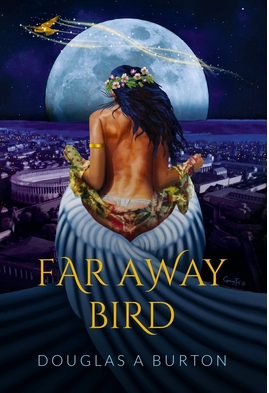
Inspired by true events, Far Away Bird delves into the complex mind of Byzantine Empress Theodora. This intimate account deftly follows her rise from actress-prostitute in Constantinople's red-light district to the throne of the Byzantine Empire.
Her salacious past has left historians blushing and uncomfortable. Tales of her shamelessness have survived for centuries, and yet her accomplishments as an empress are unparalleled. Theodora goes on to influence sweeping reforms that result in some of the first ever Western laws granting women freedom and protection. More than a millennium before the women's rights movement, Theodora, alone, took on the world's greatest superpower and succeeded. Far Away Bird goes where history classrooms fear to tread in hopes that Theodora can finally take her seat among the greatest women in history.
Theodora seems impossible--yet her transcendence teaches us that society can't tell us who we are deep down. Before there was a legendary empress, there was a conflicted young woman from the lower classes.
And her name was Theodora.
The Coffee Pot Book Club
★★★★★
Highly Recommended
Read the full review HERE!

Pick up your copy of
Far Away BirdAmazon UK • Amazon US
Douglas A. Burton
 Douglas Alan Burton is a speaker, author, and expert storyteller whose work depicts heroic figures and their deeper connection to the human experience. Doug blogs about heroes, heroines, and villains in pop culture with some unexpected and refreshing perspective. He grew up in what he describes as “the heroic boyhood culture of late Generation X” that has gone mainstream around the world. He also shares strategies with fellow writers for writing compelling heroic characters in fiction.
Douglas Alan Burton is a speaker, author, and expert storyteller whose work depicts heroic figures and their deeper connection to the human experience. Doug blogs about heroes, heroines, and villains in pop culture with some unexpected and refreshing perspective. He grew up in what he describes as “the heroic boyhood culture of late Generation X” that has gone mainstream around the world. He also shares strategies with fellow writers for writing compelling heroic characters in fiction.Douglas recently began outlining a breakthrough storytelling model that reveals a fascinating “heroine-centric” model for story structure he calls The Heroine’s Labyrinth. He believes a powerful new archetype is emerging for women in fiction. His forthcoming novel, Far Away Bird, which centers on the early life of Byzantine Empress Theodora, won the 2019 Manuscript Content for Historical Fiction from the Writers’ League of Texas.
Connect with Douglas: Website • Blog • Twitter.
Published on February 12, 2020 21:00
Carol Anne Douglas is sharing what inspired her to write The Mercutio Problem (The Merlin's Shakespeare Series Book 2) #timetravel #fiction @CarolAnneDougl1
An Author’s InspirationBy Carol Anne Douglas

Renaissance England means Shakespeare for me. Yes, the Tudors are interesting, but there are other interesting kings and queens and only one Shakespeare. Despite Henry VIII’s multiple wives and Elizabeth I’s talent for ruling, I doubt that the world would be so fascinated by the period if Shakespeare had not lived and wrote then. For me, Shakespeare’s works are the perfect playground. I enjoy and study them as they are, but stealing his sharply drawn characters is irresistible.
 William Shakespeare.
William Shakespeare.I have always loved Shakespeare’s plays in which women pretend to be men. But what if that pretense was carried further, and a girl was temporarily transformed into a man? Teenage acting student, Beth Owens, is sympathetic to gender queer people, but she is certain that her gender is female. That’s fine with her. But to save a friend she must not only pretend to be a guy, but actually become one. The immortal wizard Merlin sent Beth Owens to Shakespeare’s world and the world of Shakespeare’s characters in my young adult novel Merlin’s Shakespeare. She became close to Mercutio, but Shakespeare’s Richard III had him killed before her eyes. And Shakespeare, whom Beth idolized, never wanted to see her again because she had discovered his secret. Beth left Shakespeare’s world so shaken that she vowed never go back. Life as a high school acting student in Bethesda, Maryland, was all she wanted. But in the sequel, The Mercutio Problem, Merlin appears to her again and tells her that Richard III is still trying to wreck Shakespeare’s plays. Beth refuses to fight the evil king again. But Merlin tells her that she can bring Mercutio back to life – if she lets the wizard turn her into Mercutio. Her fondness for the unruly Venetian youth outweighs her fear of Richard. She agrees, only to learn from Macbeth’s witches that she will have to die as Mercutio to bring the real Mercutio back to life.
The Mercutio Problem
(The Merlin's Shakespeare Series Book 2)By Carol Anne Douglas
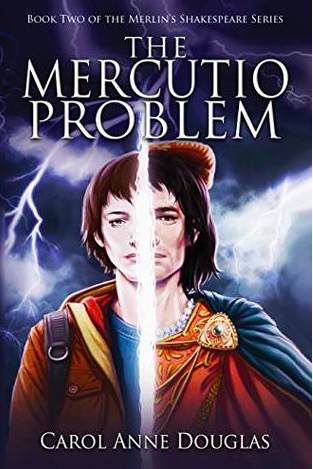
Richard III still menaces Shakespeare's world.
The immortal wizard Merlin again sends high school actor Beth Owens back to Shakespeare's London and the world of Shakespeare's characters. Beth faces danger from Richard III, who seeks to damage Shakespeare's plays. Now Merlin gives her a new challenge: bringing a character she loves back from the dead.
But she risks losing her own life...
Excerpt
She spun through frigid air. The wind forced her to close her eyes. She landed with a thunk, but upright.
Beth stood on a heath. Fog swirled around her. She could see thorny plants at her feet, but most of the heath was covered in a veil of gray. She smelled the foul aroma of a familiar cauldron. She gagged and remembered that she had never wanted to ask the witches whether the contents of the cauldron were really those that Shakespeare had enumerated, like a Turk's nose and the finger of a birth-strangled babe. She saw the cauldron's muddy liquid bubble and thought she would rather die than taste it.
"All hail Beth!" three voices cried. And three beings she had come to know appeared to her. Their bodies were green, they were blue, they were gray. They were neither female nor male, but neither were they transgender. They were their own strange lumps of almost flesh, with almost hair and eyes that were not eyes but could see far too much.
Beth had learned not to fear the witches--too much. They seemed to mean well by her. But they knew too much about everyone and everything. "Hail," she said in reply, hoping that was the right thing to say."All hail Mercutio!" they chanted. Beth flinched. "You're right, of course. Merlin wants me to pretend to be Mercutio.""Not pretend," the first witch said."To be Mercutio," chanted the second."You will be Mercutio," the third told her."That will be hard for a girl," Beth said."Not a girl," the first said."Mercutio," the second said."Truly Mercutio," said the third. Beth felt as if she had fallen into a pit. She touched her chin. There was stubble. Her body was a couple of inches taller than it had been and she had shoulder-length hair instead of her usual short light brown. She examined the ends of her hair and could see that it was dark. She wore a green doublet and hose that she had last seen on Mercutio, which was extra creepy. She even wore the boots had seen on him. And his rings were on her fingers, which looked like a man's fingers on a man's hands. One ring was emerald, another was topaz, and one was gold with the design of a falcon on it. She could hardly bear to look at the hands, which would have been fine if they weren't hers. She had calluses, probably from sword practice, on her right hand. She could feel Mercutio's sword hanging on her back. Her chest felt flat and hairy. She thought that maybe--did she feel different down there? No, not that. She felt the same, but she intended to put her hand down there as soon as she was alone, just to make sure. But otherwise she was too much like a guy. Beth gagged, and not just because of the cauldron's vapors. "Merlin turned me into Mercutio. Or almost." Her voice sounded like Mercutio's. Like a man's voice. "Merlin made me a guy. I have stubble. Too gross. I'll kill Merlin."
“Kill him? You sound like Mercutio already. But Merlin is immortal," the first witch said.
But I don't want to be a guy! I'm Beth Owens! I'm not a boy in a girl's body. I'm a girl. How can I get back to being myself?"
"In your world, you are Beth," the second witch said.
"In this world, you will be Mercutio," said the third.
Beth stared at her hairy hands. "I want to be with him, not to be him. Is it true that my being him can bring him back?"
"Bring him back," the witches chorused.
"But how, if I'm Mercutio, can he come back?"
The witches cackled. "You don't guess?"
"No. How can he come back?"
"When you die," chanted the first witch.
"You die," chanted the second.
"He will come back when you die," chanted the third.
"Die?" Beth gasped. She fell backwards, tearing her velvet sleeve on a gorse bush. "No, that's too much." Her voice cracked. "I don’t want to die."
"In this world," the first witch said.
"Die in this world? But not in mine?" Beth asked. She tried to stand up even though her legs felt weak.
"Die as Mercutio, not as Beth," the second witch said.
So, probably not in her own world. But it would be scary enough to die in this world. "I don't want to."
"He died for you," the third witch reminded her.
"Oh." Beth stood there in shock. Yes, Mercutio had died trying to defend her from Richard. But Mercutio was a character, and could live again. She was human, and could die only once. Maybe.
Beth shook her head. "It's too much."
"Too much," the witches echoed. "Too much." "Tell Merlin," the first witch said.
"That you won't save Mercutio," the second witch said."Let Mercutio stay dead," the third witch chanted.
"No!" Beth exclaimed. "I'll do it." "Beth will do it," the witches chanted. "Beth will die. In this world."
The witches vanished. Even though she saw no one else on the foggy heath, Beth went behind a large gorse bush. She pulled down her breeches. Even though the rest of her looked male, she was still female down there. What a relief! She pulled her breeches up again. She imagined being Mercutio even when she had her period. That thought made her smile.Beth spun away, choking in the fog. She landed on her bed.
I'm crazy, she thought. She leapt up and looked in her mirror. Her face was Beth's face. Her hands were Beth's hands. She was female again. She had never thought of herself as super-feminine, but she combed her hair and changed her slacks to a skirt just to reassure herself that in her own world she was a girl.
Pick up your copy ofThe Mercutio ProblemAmazon UK • Amazon US
Carol Anne Douglas
 Carol Anne Douglas enjoys living in previous centuries as well as her own. She has spent many years studying the Arthurian legends and Shakespeare’s plays. Her previous novels include
Lancelot: Her Story
, in which Lancelot is a woman in disguise (Hermione Books, 2016), Lancelot and Guinevere, the sequel (Hermione Books, 2016), and
Merlin’s Shakespeare
(Hermione Books, 2018), the predecessor to
The Mercutio Problem.
Her profession is editing. When she isn’t writing or reading, she is hiking in national parks and watching birds.
Carol Anne Douglas enjoys living in previous centuries as well as her own. She has spent many years studying the Arthurian legends and Shakespeare’s plays. Her previous novels include
Lancelot: Her Story
, in which Lancelot is a woman in disguise (Hermione Books, 2016), Lancelot and Guinevere, the sequel (Hermione Books, 2016), and
Merlin’s Shakespeare
(Hermione Books, 2018), the predecessor to
The Mercutio Problem.
Her profession is editing. When she isn’t writing or reading, she is hiking in national parks and watching birds. Connect with Carol Anne: Website • Twitter.
Published on February 12, 2020 20:00
February 11, 2020
Join me in Conversation with #HistoricalFiction author, Gemma Lawrence #Medieval #Interview @TudorTweep

A Conversation with Historical Fiction author, Gemma Lawrence
Please give a warm Coffee Pot welcome of Gemma Lawrence.
MA: Gemma, thank you for dropping in to chat with us today. Before we begin, could you please tell my readers a little about yourself.
GL: Lovely to be here, and thanks for having me! My name is Gemma Lawrence, and I am an independent author. I go by the name G. Lawrence, and I mainly write historical fiction concentrating on the Tudor and Medieval periods, but I have also written a small selection of fantasy novels, and re-writes of fairy stories. When I write historical fiction, I write about women of history I admire, and find captivating.
MA: What inspired you to write your recent book, Child of Water ?
 GL: Child of Water is the first book in a series I’m writing called Heirs of Anarchy, about the life of the Empress Matilda, daughter of King Henry I of England and Duke of Normandy. Matilda was named heir to her father’s kingdom in 1127 during the lifetime of King Henry. Barons of England and Normandy swore to uphold her as Queen upon the death of her father, but her cousin Stephen stole the crown from her, leading to years of civil war as the two cousins, one male and one female, fought to become monarch. It is a period known today as the Anarchy. Child of Water covers a period before this conflict, the early life of Matilda, when she was the child-wife and Queen of Emperor Heinrich V of the Holy Roman Empire and later Empress and regent of northern Italy. The latter part of the book concentrates on her return to Normandy, when she was once more under the power of her father. The next two books in the series will examine the period before the civil war, and then the Anarchy itself. After Matilda’s story will come that of her daughter-in-law, Eleanor of Aquitaine, the Queen of Matilda’s son, Henry II, who will continue the story onwards as the first of the Plantagenet kings takes the throne.
GL: Child of Water is the first book in a series I’m writing called Heirs of Anarchy, about the life of the Empress Matilda, daughter of King Henry I of England and Duke of Normandy. Matilda was named heir to her father’s kingdom in 1127 during the lifetime of King Henry. Barons of England and Normandy swore to uphold her as Queen upon the death of her father, but her cousin Stephen stole the crown from her, leading to years of civil war as the two cousins, one male and one female, fought to become monarch. It is a period known today as the Anarchy. Child of Water covers a period before this conflict, the early life of Matilda, when she was the child-wife and Queen of Emperor Heinrich V of the Holy Roman Empire and later Empress and regent of northern Italy. The latter part of the book concentrates on her return to Normandy, when she was once more under the power of her father. The next two books in the series will examine the period before the civil war, and then the Anarchy itself. After Matilda’s story will come that of her daughter-in-law, Eleanor of Aquitaine, the Queen of Matilda’s son, Henry II, who will continue the story onwards as the first of the Plantagenet kings takes the throne. That is what the book is about, and the inspiration was Matilda herself. I have, in fact, been dying to write this story for a long time. Reading about Matilda, the woman who could have become the first regnant Queen of England and Normandy so long ago, and her fight for the throne, enthralled me from the start. She was a strong willed, highly-educated, confidant woman who never faltered in her belief that she was able to rule, and was righteous in her claim to the throne. Matilda was condemned a great deal for displaying arrogance and coldness, but many of the traits she demonstrated were lauded in male rulers. It was not a time of gentle kings and monarchs, and she is no exception in this regard, but I saw more in her that was throne worthy than I think those chronicling her actions at the time did.
 Portrait of Empress Mathilda, from "History of England" by St. Albans monks (15th century); Cotton Nero D. VII, f.7, British Library.
Portrait of Empress Mathilda, from "History of England" by St. Albans monks (15th century); Cotton Nero D. VII, f.7, British Library.I find the idea England might have had a female ruler so early in its history intriguing. What could that have altered in the future? Would it have changed the way society thought about female power, or would not a great deal have changed? Of course even the slightest alteration in history could change everything that followed, but I find the subject fascinating; as fascinating as the idea of a woman pressing for rights that had not been conferred on a woman before that time, with such vim and courage, as Matilda did. Matilda was a remarkable woman. In her lifetime, she was an Empress, twice a Queen, a Countess, the daughter and mother of kings as well as the leader and figurehead of an army. She had energy, intelligence, courage, self-belief and not a little pride and stubbornness. No person is perfect, and she certainly had flaws, but I admired her when reading about her and wanted to tell her story.
MA: Your new book series sounds amazing. Like you, the life of Matilda has always fascinated me.
How did you come up with your characters and your setting?
GL: My characters come from the historical records. I don’t tend to include “made up” main characters in my books, (of course, all characters in my books are made up to an extent) and only put in people who are entirely from my imagination if they are common people or servants. Servants’ lives were not as well recorded as nobles, so inventing a person here and there to be a friend, companion or part of a household does not change the historical facts of the story. Making up main characters does. When it comes to main characters, I take people who actually existed and build characters into them. I try to work from descriptions, physical and of character, about them, so that I am not altering an actual historical figure too greatly, but conversations, relationships, private times, these are all things that come to me as I write. You could say I take a skeleton of a character from what is written about them in historical sources, and I put flesh on their bones. At least, that is the idea!
As for setting, the world has changed a great deal since the times of Matilda, and therefore I read widely about the way the countryside was and how it has altered, methods of travel, farming, house and castle construction etc. But many of the physical descriptions of the world of the book come from walks I take with my dog. Although landscape may alter, the pictures of the countryside, antics of animals and insects, I include in my books are largely things I have seen as I walk in forests and along beaches with my (rather aged but still game) dog, Toby. I carry a notebook, and write down everything that occurs as I walk, including random thoughts and things I find beautiful. Walking is an important part of my job, in so many ways. Typing and reading for hours can make muscles stiff and bones creaky, so walking helps me to prevent my body turning into one big knot. Often walking is when I get some of the best ideas I have, too, which is why I learned to carry a notebook, so I don’t miss them. Toby has learned to be patient with me; he sniffs out good smells as I scribble!

MA: Your dog is gorgeous. It is such a good idea to carry a notebook around with you.
There are many books in the historical fiction genre. Can you tell us three things that make yours stand out?
GL: I would say, firstly, that there are so many books in all genres of fiction, and non-fiction. A new author might look at all the books in the world and think what on earth could they offer? I think what all writers have to offer is our voice, our own perspective. Everyone writes differently, and that makes each book distinct.
When it comes to historical fiction, one hundred people could look at the life of a historical figure like the Empress Matilda, or Anne Boleyn, and write one hundred completely different books, not different in subject matter or events, but interpretation. Some might be understanding of certain characters, others might condemn. Some might concentrate on politics and some on internal feelings. I think that is what matters when it comes to historical fiction; the eye of the writer; the way they see the characters of people long since dead and times now passed, customs and traditions forgotten. The subject matter might be well known, but the way we all look at events, people, actions, is not. The way each person chooses to bring the past to life is what makes each historical fiction book different from another.
As to what makes mybooks different, I think detail is one. I write a series of books about a historical figure rather than one book. Before I was a writer, I found some historical fiction, no matter how much I liked it, frustrating because even a long book missed out so much from the life of the main character, and about their lives and times. When I came to write, I included the detail I had wanted to see in books I had read, in my books. The trick was learning when to stop! Some of my readers love this attention to detail, describing the world of the past, about my books, and some, who I suspect do not remain my readers, hate it. But whilst I am sorry to lose any readers, it is a thing impossible to please everyone when it comes to books. Reading is a subjective experience, after all. As long as the majority of the people reading my books like the detail I go in for, clothes, jewels, food, drink, etc, I am happy. Really, I’m still writing for myself, even now. I love history, and I want to breathe and taste the past. That is what I try to do; bring the past to life with detail.
I tend to write in first person perspective, also, which was and is a conscious choice. I am more comfortable with it, for one thing, and I think it grants a sense of immediacy, especially in times of fear or pleasure, which pulls the reader closer to the main character. I like to examine the thoughts and feelings of my main character, create a feeling of connection with a person who died long ago, and immerse the reader into the world I have created. I want readers to be able to feel as though they can touch the past, as though they are there. The best way, I think, to do that is to open the mind of the main character to them, let them see through their eyes, using this style of writing.
Perhaps the last thing to make my books different is that I do not, as some historical authors do, alter major or main events of the past to suit the book. Where an event is recorded, it remains. I am not writing in order to change history. I might put another slant or interpretation on it, might choose to go with one source’s version of events or another, but in my books I want history to remain history. Where events are vague, I have to invent what my characters are up to, but otherwise I try to stick to fact. I take a chain of events in a life, and weave my story and characters about them. I understand why some authors alter history, and my choice not to is not a judgement on that, (I, in fact, enjoy reading some works of alternate history) but what I find fascinating about history is history, so with my books, I try to stick to the facts, as far as they are known, for the main events.
MA: One last question… Can you share with us what you are currently working on?
GL: At the moment, I am editing a re-telling of Cinderella, which I hope to have out later in the year, and drafting the next book in Heirs of Anarchy. Later in the year I will be returning to my ongoing series on the life of Elizabeth I, with a book covering the latter part of her life, called Old Foxes. So, busy, busy! But I am always busy, always writing. It is my full-time job, which is something I treasure because I know how fortunate I am to be able to do what I love for a living. It is also my hobby, because I spend a lot of my spare time researching my books.
But writing is also vital to me. It has carried me through some of the worst, and helped me to enjoy some of the best, times of my life. I would be lost without it. I don’t, therefore, mind being busy at all. I am an independent author, so all my deadlines are self-imposed. I am very strict! Sometimes I think I set myself impossible goals, and my to-do list is frankly terrifying at times, but I wouldn’t do anything else. Writing is my job, my obsession, and although it offers struggle and pain (of the neck, more than anything) at times, it is one of the greatest joys of my life. It is where I go to escape the world, and it is how I understand it, too.
MA: Thank you so much for taking the time out of your day to chat with us today.
If you would like to learn more about Gemma’s fabulous new series, then you know what to do. Scroll Down!
Child of WaterBook One Of The Heirs of AnarchyBy Gemma Lawrence

Winter, 1110, England
On a beach, standing in the snow, a girl of eight winters waits for a ship that will take her from her homeland of England, from her family, to her husband. That girl is Matilda, daughter of Henry I, King of the English and Duke of Normandy. In time she would become Queen of the Germans and Romans, and Empress of the Holy Empire.
From the dark forests and mighty castles of the German states of the Empire, to the Alps, northern Italy and Rome, Matilda will travel, at first the apprentice of power, learning from her husband, Heinrich, the Emperor. Through times of war and peace, loss and deepest sorrow, her story unfolds, leading her back to the place of her birth, and the promise of a throne.
Child of Water is the first book in the series The Heirs of Anarchy, by G. Lawrence.
Pick up your copy ofChild of WaterAmazon UK • Amazon US
Gemma Lawrence
 I am an independently published author, and proud to be so. Living in a little cottage in Wales in the UK, I love where I live as much as I love to write.
I am an independently published author, and proud to be so. Living in a little cottage in Wales in the UK, I love where I live as much as I love to write.The age of the Tudors has been an obsession for me since I was a child, and many of my upcoming books will centre on that time, but I also pen the odd dystopian fiction or historical fiction from other time periods. I will be releasing all my titles on amazon, for kindle and then hopefully for print later.
I studied Literature (with a capital L) at University and usually have twenty or more books I'm currently reading. Reading and writing are about mood for me, and I haven't found a genre I didn't enjoy something about so far...
You can often find me on Wattpad or Twitter when I'm not writing...
Published on February 11, 2020 21:00
The Coffee Pot Book Club
The Coffee Pot Book Club (formally Myths, Legends, Books, and Coffee Pots) was founded in 2015. Our goal was to create a platform that would help Historical Fiction, Historical Romance and Historical
The Coffee Pot Book Club (formally Myths, Legends, Books, and Coffee Pots) was founded in 2015. Our goal was to create a platform that would help Historical Fiction, Historical Romance and Historical Fantasy authors promote their books and find that sometimes elusive audience. The Coffee Pot Book Club soon became the place for readers to meet new authors (both traditionally published and independently) and discover their fabulous books.
...more
...more
- Mary Anne Yarde's profile
- 159 followers



